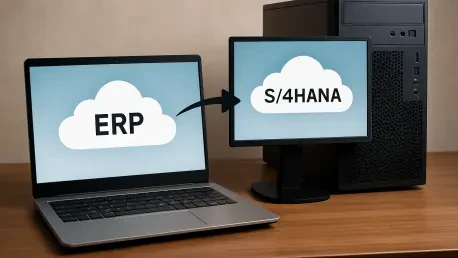As the deadline for mainstream support of legacy SAP systems like ECC looms just two years away in 2027, a significant number of North American organizations find themselves grappling with the daunting transition to S/4HANA, a modern platform that promises enhanced agility and productivity. Yet, the journey to adoption is proving to be a complex and resource-intensive endeavor for many. Recent research from industry groups reveals that while progress has been made, a substantial portion of users remain tethered to older systems, risking operational disruptions as support phases out. The urgency to migrate is palpable, with extended support options available until 2030 but at a steep additional cost. This scenario sets the stage for a critical examination of why so many companies are lagging behind and what barriers are preventing a smoother shift to this next-generation ERP solution. The challenges are multifaceted, spanning technical intricacies, cultural resistance, and financial justifications, painting a picture of an industry at a crossroads.
Navigating the Migration Maze
The complexity of moving to S/4HANA stands out as a primary hurdle for North American SAP users, with the process often requiring a complete overhaul of core data management and operational frameworks. A survey conducted among 173 members of a prominent SAP user group indicates that nearly half of respondents—49 percent—point to business process changes as the biggest obstacle. This isn’t merely a technical upgrade but a fundamental rethinking of how organizations operate, demanding significant time and resources to redesign workflows. Many companies have spent years tailoring their legacy ECC systems to specific needs, and transferring these customizations to S/4HANA isn’t straightforward. The push for a “clean core” approach, where extensions are built outside the core system on a cloud-based platform, adds another layer of difficulty, often necessitating custom tools or manual interventions to bridge the gap between old and new.
Beyond the technical challenges, the sheer scale of customizations poses a persistent barrier, as highlighted by 44 percent of surveyed users facing issues with adapting tailored solutions. These customizations, while critical to past operations, often clash with the standardized tools offered for migration, creating a bottleneck that slows down the transition. The reality is that many organizations are not just upgrading software; they are reimagining their entire business architecture to align with S/4HANA’s capabilities. This requires not only technical expertise but also a willingness to let go of long-standing practices that may no longer fit within the new system’s framework. Compounding the issue is the lack of clear guidance on how to handle these discrepancies, leaving companies to navigate uncharted territory with limited support. As the clock ticks closer to the end of mainstream support, the pressure to resolve these issues intensifies, underscoring the need for strategic planning and robust execution to avoid falling behind.
Overcoming Organizational and Financial Barriers
Resistance to change within organizations emerges as another significant impediment, with 37 percent of North American SAP users citing cultural and operational inertia as a key challenge. The shift to S/4HANA isn’t just about technology; it demands a mindset transformation across departments, often underestimated by leadership. Employees accustomed to legacy systems may view the migration as a disruption rather than an opportunity, creating friction that slows progress. This cultural barrier is compounded by the difficulty of managing change on a large scale, where aligning diverse teams under a unified vision becomes a Herculean task. The reluctance to embrace new processes often stems from a lack of understanding of the long-term benefits, making it harder to rally internal support for such a transformative project. Addressing this requires targeted communication and training to bridge the gap between current practices and future goals.
Financial justification adds yet another layer of complexity, as a staggering 95 percent of legacy users struggle to build a compelling business case for migrating to S/4HANA. Despite the platform’s touted benefits like improved efficiency and real-time analytics, the upfront costs and potential disruptions deter many organizations from taking the leap. The investment required for migration—spanning software, consulting, and training—can be substantial, and without a clear return on investment, decision-makers hesitate to commit. Additionally, widespread uncertainty about SAP’s migration policies and deadlines, with 83 percent of users lacking full clarity, exacerbates the problem. This confusion, coupled with concerns over operational impacts noted by 84 percent of respondents in a separate study, creates a paralyzing effect. Companies need better education and transparent messaging to navigate these financial and strategic uncertainties before the support deadline in 2027 forces their hand.
Charting the Path Forward
Reflecting on the journey so far, the struggle of North American SAP users to transition to S/4HANA has been marked by a blend of technical hurdles, organizational resistance, and financial dilemmas. About 40 percent of users had yet to begin their migration, a statistic that underscores the scale of the challenge as the mainstream support deadline approaches. The complexities of reengineering business processes and adapting customizations stand as towering obstacles, while cultural inertia slows internal momentum. Financial hesitations and unclear policies further muddy the waters, leaving many companies uncertain of their next steps.
Looking ahead, the focus must shift to actionable strategies that pave the way for success. Companies should prioritize comprehensive planning, leveraging expert consultations to map out migration roadmaps tailored to their unique needs. Investing in employee training to ease cultural transitions and building robust business cases with clear metrics can help secure buy-in from stakeholders. Collaboration with SAP and user communities to clarify policies and deadlines will also be crucial. By taking these proactive measures, organizations can mitigate risks and position themselves to harness the full potential of S/4HANA before support for legacy systems fully phases out.









